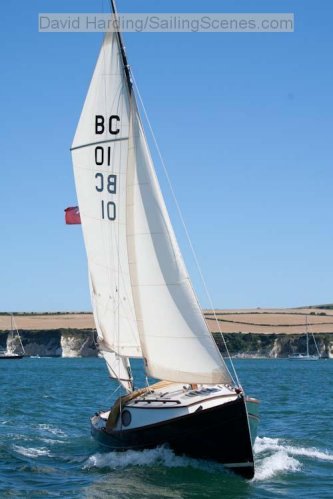This view ahead shows the benefit of mounting the jib directly on the stem. The view forward is much improved. Matt Newland is concerned about sailing like this in case the bearings fail in the drum, or the furling jams as you can't lower the sail without dropping the mast. We are going to look into alternative arrangements over the winter. You can aslo see the lazyjack tightening mechanism, which works very well.
I haul out next weekend so I thought I had better get more practice at dealing with the mast. I beached her on Redhorn Point near the mouth of the harbour, stuck my brand new mast support thingy into the mizzen socket and lowered the mast without any consequences at all. I unbolted it at the tabernacle and slid it forward to see what the overhang was at the rear. It is not too much at all, so I shall tow her like that, with the mast in one piece.
 Having lowered the mast and stowing it all, I decided there was little point in raising it again as I would have to motor back and then lower it again at the end of the week. I was also interested to see how easy it is to motor with the mast down. The answer is that you can do it, but the mast obscures your view. I actually stood up for the whole journey, which was comfortable as you can lean on the mast. I like to stand when sailing or motoring in very shallow water, as you can see approaching problems much more easily. If I motor her down the Thames, as we plan for next year, I shall leave the masts at home.
Having lowered the mast and stowing it all, I decided there was little point in raising it again as I would have to motor back and then lower it again at the end of the week. I was also interested to see how easy it is to motor with the mast down. The answer is that you can do it, but the mast obscures your view. I actually stood up for the whole journey, which was comfortable as you can lean on the mast. I like to stand when sailing or motoring in very shallow water, as you can see approaching problems much more easily. If I motor her down the Thames, as we plan for next year, I shall leave the masts at home.




Ahoy,
ReplyDeleteIt´s very nice blog.
I have seen much information for me. Your Daisy Grace is pretty light boat. Your videos (launching..., tests, trailering home ) and pictures inspired me.
Many thanks for information about Shilling ( Margherita ) cutter.
I am looking for any ideas and proposals, how to do a little schooner with cabin simmilar to Daisy or Margherita. I would like to build a semi replica schooner like the replica Lion ( Lynx, Pride of Baltimore.... ) More about my dream you can see there : http://www.woodenboatforum.com/forum/showthread.php?t=105181
I ordered study plan of Shilling. But i think The Shilling hasn´t any water ballast tanks. It´s pity for me, beacuse semi replica Lynx ( Lion, Pride of Baltimore ....) will be need any water ballast tanks.
i am again... :-)
ReplyDeleteSo can you show ( discribe )me more about water ballst tanks an bilge pump system used in Daisy ?
Are those pumps manual or electrical 12V ?
My e-mail : dzitny@orangemail.sk
Many thanks
Dušan
Hi Dusan. Sorry for the delay in reply, I hadn't spotted this note. The BayCruiser has two ballast tanks, one under the forward berth and one under the cockpit. They are linked by a plastic pipe which runs through the cabin. They are filled from a single self bailer in the cockpit tank, which faces forward. when you open it, water is forced in. Both tanks are pumped out with a single hand pump, which is in the cockpit, but the suction end of it is in the forward tank. It takes about 10 minutes to fill and 15 minutes to pump out. Total volume 400 litres, so it added 400kg of ballast. It all works very well.
ReplyDelete